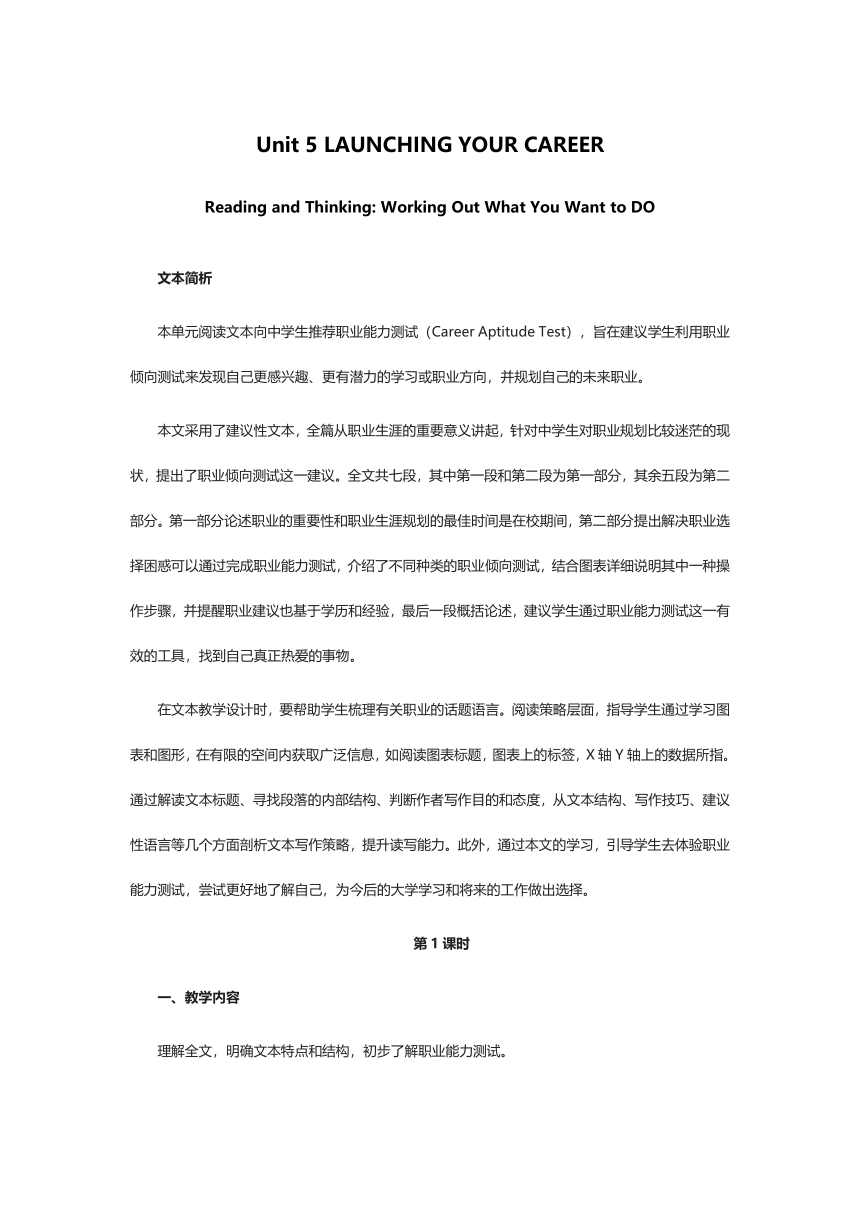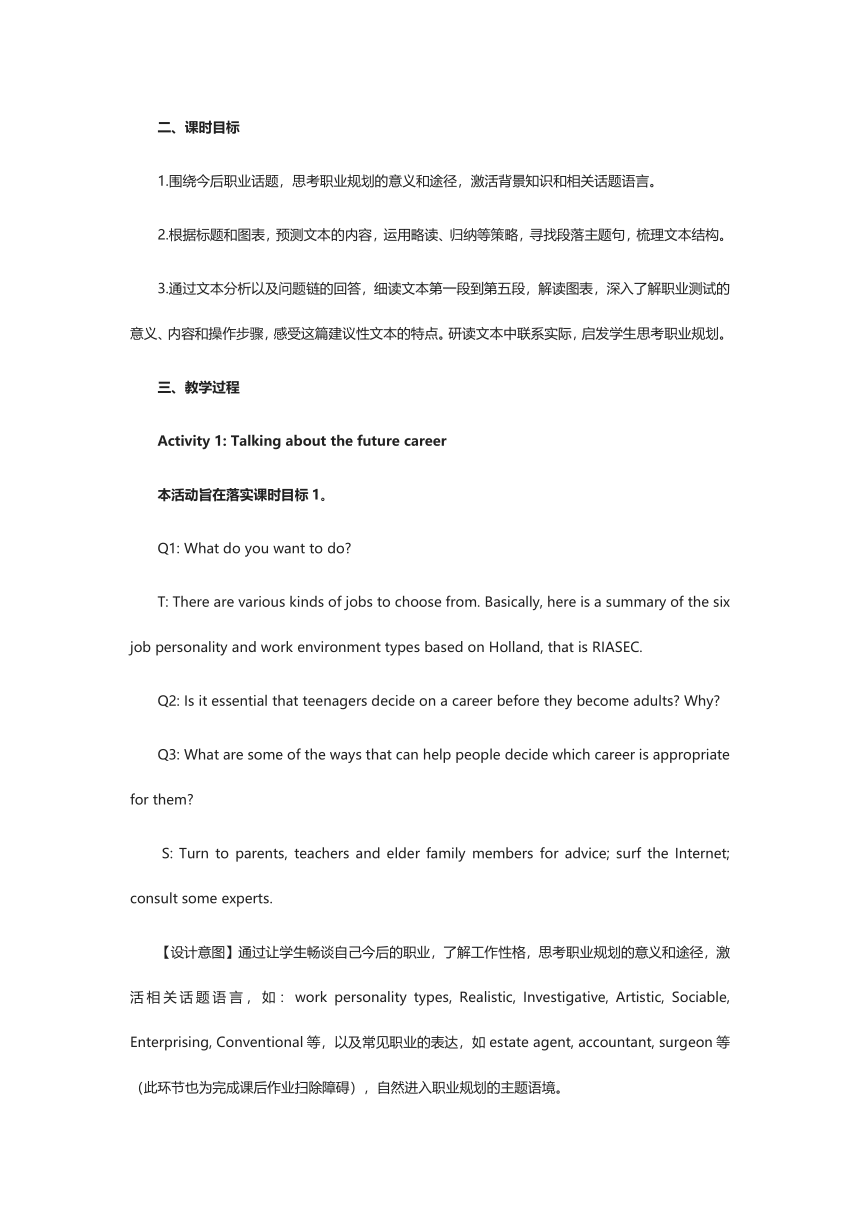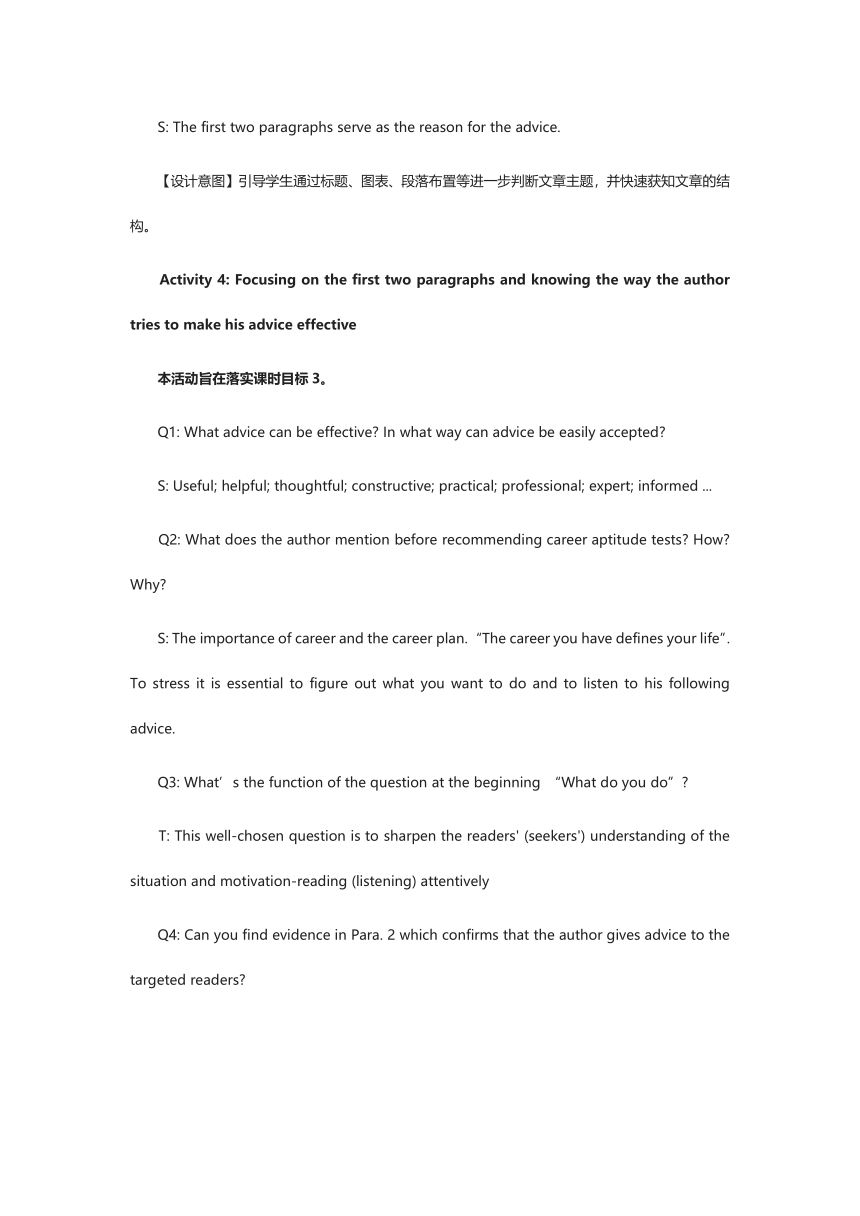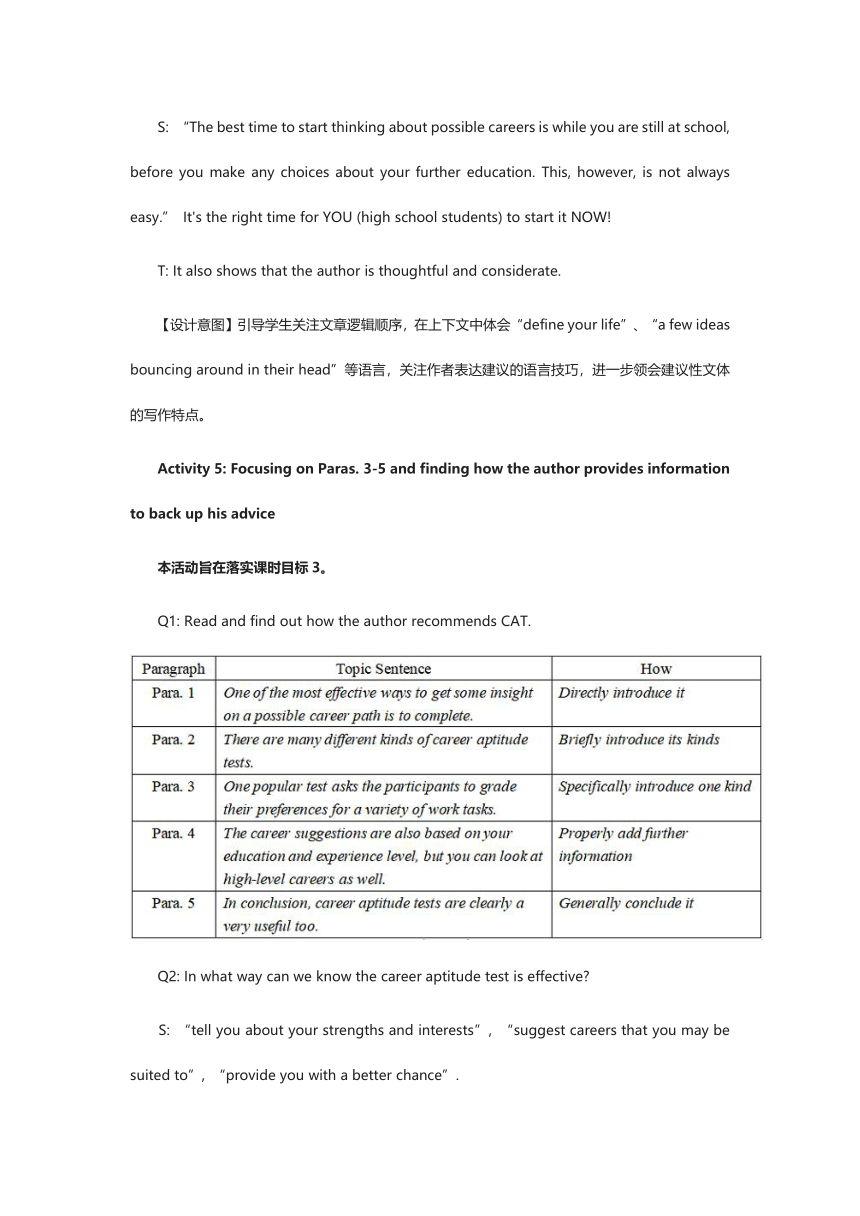Unit 5 LAUNCHING YOUR CAREER Reading and Thinking Working Out What You Want to DO教学设计
文档属性
| 名称 | Unit 5 LAUNCHING YOUR CAREER Reading and Thinking Working Out What You Want to DO教学设计 |  | |
| 格式 | zip | ||
| 文件大小 | 430.0KB | ||
| 资源类型 | 教案 | ||
| 版本资源 | 人教版(2019) | ||
| 科目 | 英语 | ||
| 更新时间 | 2022-06-11 13:00:43 | ||
图片预览





文档简介
Unit 5 LAUNCHING YOUR CAREER
Reading and Thinking: Working Out What You Want to DO
文本简析
本单元阅读文本向中学生推荐职业能力测试(Career Aptitude Test),旨在建议学生利用职业倾向测试来发现自己更感兴趣、更有潜力的学习或职业方向,并规划自己的未来职业。
本文采用了建议性文本,全篇从职业生涯的重要意义讲起,针对中学生对职业规划比较迷茫的现状,提出了职业倾向测试这一建议。全文共七段,其中第一段和第二段为第一部分,其余五段为第二部分。第一部分论述职业的重要性和职业生涯规划的最佳时间是在校期间,第二部分提出解决职业选择困惑可以通过完成职业能力测试,介绍了不同种类的职业倾向测试,结合图表详细说明其中一种操作步骤,并提醒职业建议也基于学历和经验,最后一段概括论述,建议学生通过职业能力测试这一有效的工具,找到自己真正热爱的事物。
在文本教学设计时,要帮助学生梳理有关职业的话题语言。阅读策略层面,指导学生通过学习图表和图形,在有限的空间内获取广泛信息,如阅读图表标题,图表上的标签,X轴Y轴上的数据所指。通过解读文本标题、寻找段落的内部结构、判断作者写作目的和态度,从文本结构、写作技巧、建议性语言等几个方面剖析文本写作策略,提升读写能力。此外,通过本文的学习,引导学生去体验职业能力测试,尝试更好地了解自己,为今后的大学学习和将来的工作做出选择。
第1课时
一、教学内容
理解全文,明确文本特点和结构,初步了解职业能力测试。
二、课时目标
1.围绕今后职业话题,思考职业规划的意义和途径,激活背景知识和相关话题语言。
2.根据标题和图表,预测文本的内容,运用略读、归纳等策略,寻找段落主题句,梳理文本结构。
3.通过文本分析以及问题链的回答,细读文本第一段到第五段,解读图表,深入了解职业测试的意义、内容和操作步骤,感受这篇建议性文本的特点。研读文本中联系实际,启发学生思考职业规划。
三、教学过程
Activity 1: Talking about the future career
本活动旨在落实课时目标1。
Q1: What do you want to do
T: There are various kinds of jobs to choose from. Basically, here is a summary of the six job personality and work environment types based on Holland, that is RIASEC.
Q2: Is it essential that teenagers decide on a career before they become adults Why
Q3: What are some of the ways that can help people decide which career is appropriate for them
S: Turn to parents, teachers and elder family members for advice; surf the Internet; consult some experts.
【设计意图】通过让学生畅谈自己今后的职业,了解工作性格,思考职业规划的意义和途径,激活相关话题语言,如:work personality types, Realistic, Investigative, Artistic, Sociable, Enterprising, Conventional等,以及常见职业的表达,如estate agent, accountant, surgeon等(此环节也为完成课后作业扫除障碍),自然进入职业规划的主题语境。
Activity 2:Predicting the content of the passage
本活动旨在落实课时目标2。
Students look at the title of the passage and the chart and the graph.
Q1: What does the phrasal verb “work out” mean in the title
Two definitions of it will be given for students to choose from, but the teacher will not give the answer at that moment.
Q2: According to the title and the charts below, what is the passage about
S: It gives us advice on what to do in the future.
【设计意图】引导学生通过解读标题,来预测阅读内容。
Activity 3: Getting the main advice and the structure of the passage
本活动旨在落实课时目标2。
Q1: What is the main advice given to readers And Why
S: Take a career aptitude test because “career aptitude test” is mentioned again and again, and there is a career aptitude test example, and a chart showing the test results.
Q2: How many paragraphs cover the key advice “career aptitude test” directly
S: Five paragraphs. From Para. 3 “One of the most effective ways...is to complete 'career aptitude test'” to Para. 7 “In conclusion, career aptitude tests are clearly a very useful tool”.
Q3: So the last five paragraphs are about the “career aptitude test”, then what about the first two paragraphs
S: The first two paragraphs serve as the reason for the advice.
【设计意图】引导学生通过标题、图表、段落布置等进一步判断文章主题,并快速获知文章的结构。
Activity 4: Focusing on the first two paragraphs and knowing the way the author tries to make his advice effective
本活动旨在落实课时目标3。
Q1: What advice can be effective In what way can advice be easily accepted
S: Useful; helpful; thoughtful; constructive; practical; professional; expert; informed ...
Q2: What does the author mention before recommending career aptitude tests How Why
S: The importance of career and the career plan. “The career you have defines your life”. To stress it is essential to figure out what you want to do and to listen to his following advice.
Q3: What’s the function of the question at the beginning “What do you do”
T: This well-chosen question is to sharpen the readers' (seekers') understanding of the situation and motivation-reading (listening) attentively
Q4: Can you find evidence in Para. 2 which confirms that the author gives advice to the targeted readers
S: “The best time to start thinking about possible careers is while you are still at school, before you make any choices about your further education. This, however, is not always easy.” It's the right time for YOU (high school students) to start it NOW!
T: It also shows that the author is thoughtful and considerate.
【设计意图】引导学生关注文章逻辑顺序,在上下文中体会“define your life”、“a few ideas bouncing around in their head”等语言,关注作者表达建议的语言技巧,进一步领会建议性文体的写作特点。
Activity 5: Focusing on Paras. 3-5 and finding how the author provides information to back up his advice
本活动旨在落实课时目标3。
Q1: Read and find out how the author recommends CAT.
Q2: In what way can we know the career aptitude test is effective
S: “tell you about your strengths and interests”, “suggest careers that you may be suited to”, “provide you with a better chance”.
Q3: What is a head start
S: You begin earlier or further ahead than someone else, which will be an advantage that helps you to be successful.
Q4: By saying “I wish I had thought more about what I really wanted to do.”, what is the tone of the author
S: Getting our involvement in deciding what you should do—Give One a Try.
Q5: What is very important when you are completing the test
Q6: How does the author introduce one popular test in a different way
S: The author specifically introduces it in several steps and illustrations beside.
Q7: Do you know how to read charts, which convey a wide range of information in a limited space.
【设计意图】引导学生感知文本如何有条理地介绍职业能力测试:从归属(是一种有效的能力测试)、种类、操作步骤、补充,再到小结,领悟到这是个清晰的、科学的阐述过程。同时,指导学生学会读取图表中隐含的大量数据。
Assignments:
1.Try a free test online, get some career suggestions and share them with at least two friends.
2.Match six types of work personality with their descriptions on your worksheet.
3.Ex 4 on P51: Decide on which personality type these jobs mostly relate to.
【设计意图】学生巩固所学语言内容,强化主题语言。启发学生研读文本后联系实际,真正去体验一次职业能力测试,积极思考职业规划。
第2课时
一、教学内容
继续研读职业能力测试,探究其可能存在的缺陷,探讨有助于职业选择的其它可行方法。
二、课时目标
1.通过讨论将不同职业进行职业性格分类,交流个人参加职业能力测试的体验,形成对该测试的新认识,培养求同辨异的批判性思维能力。
2.继续学习文本的第六段和第七段,获得作者对职业能力测试的观点。纵观全文,深入体会作者在推荐职业能力测试时所持的态度和方法,学会分析、归纳等逻辑思维。
3.结合文本中获得的启示,和实际情况——学生马上高中毕业,面临大学专业的选择和将来择业的挑战,学生进一步思考怎样利用即将到来的暑假,为在将来的学习和工作的选择获得更多的参考,最后撰写一篇建议信,提高联想、想象、模仿、创生的创新思维。
三、教学过程
Activity 1: Sharing the experience of an online career aptitude test and discussing how to classify the jobs.
本活动旨在落实课时教学目标1,并为课时教学目标2做铺垫。
1.Students share their experience of an online career aptitude test.
2.Match six types of work personality with their descriptions. Check Exercise 4 on page 51: Decide on which personality type these jobs mostly relate to.
T:Majority of career tests use Holland codes, developed by American psychologist Dr. John L. Holland, to match people with appropriate jobs according to their interests. Career aptitude tests are usually only able to match to generic careers like teacher, nurse and police officer. They don’t typically include every career option, or even more specific or unusual professions.
Q: What other factors are taken into consideration in the career suggestions
S: Education and experience level
【设计意图】此活动既是第一课时作业分享,更是鼓励学生学习要联系实际,要辩证看待职业能力测试以及职业性格分类,同时激发学生思考还没有其它影响职业建议的因素。
Activity 2: Focusing on Paras. 6-7 and finding the author’s attitude toward career aptitude tests and career suggestions.
本活动旨在落实课时目标2。
Q1: How does the author convey that there are other factors
S: “also”, “as well”.
Q2: Why are higher-level careers recommended to high school students
Q3: What does the author most likely want to convey in the last paragraph What is the tone of his writing
S: The key to a good career is finding what you are passion about and CATs are only meant for guidance as a very useful tool.
T: The author tries to provide truly useful advice and keep it real.
【设计意图】学生课前体验了职业能力测试,又在课内通过讨论完善自己的看法,这时再通过阅读最后两段,寻找作者对此的观点和态度,不仅对职业能力测试有更全面的认识,也学会更客观分析,辩证看待事物。
Activity 3: Focusing on how the author conveys his advice and makes it effective
本活动旨在落实课时目标2。
Q1: What are common ways to give advice in English
S: should/ought to
had better
Why not … /Why don’t …
Conditional
would
Imperative
How about/what about + -ing
Let’s … and let’s not …
can/could/may/ Can’t you …
I suggest/advise/recommend...
Q2: In what way does the author recommend the career aptitude test
S: Imperative; can/could/may/
Q3: But why are there not so many different way. If in another way, say “Let’s”, is it still acceptable
T: Giving Advice is more of an art than a science. Let’s see how he successfully makes it. And that’s also the advice we can learn from the passage—How to Offer Effective and Thoughtful Advice
Para. 1: To make it worthwhile, you need to make sure it’s relevant and people you’re talking/writing to actually want to receive it.
Para. 2: To make it thoughtful, you'd better show your understanding of their problem.
Paras. 3-6: To make it informed, you can provide process guidance especially with relevant expertise.
Para.7: To make it acceptable, you should be honest.
Q4: What does the phrasal verb “work out” mean in the title Why
1. If you work out a solution to a problem or mystery, you manage to find the solution by thinking or talking about it.
2. If you work out the answer to a mathematical problem, you calculate it.
—from Collins English Dictionary
Ss/T: 1 and 2. Choosing a career for yourself is rarely a simple decision. By asking questions, career aptitude tests aim to challenge your way of thinking, then recommend certain career types based on your responses. It’s the quality of the data that determines the quality of the results.
【设计意图】学生再次回顾文本,重新梳理作者推荐“职业能力测试”的思路和语言,明白并不是所有的建议都要用“should”“let’s”等等,而是要看给建议的人和接受建议的人的身份和他们之间的关系。此文是带有介绍性质的建议性文体,作者应为长者或学者,面对的是学生,所用语言简单明了、客观、实事求是,认同、鼓励但不煽情。回归到课文标题,解读出work out的两层意思。
Activity 4: Thinking after reading
本活动旨在落实课时目标3。
Q1: What do you think of a career aptitude test Could there be some problems with this sort of test
Q2: What other things could you do to help you decide on possible future careers
S: Complete a “career aptitude test”
Find a volunteer gig you’ll actually enjoy
Shadow someone in a job you’re interested in
Find time to learn something new
Consult parents and teachers
...
T: Different career tests take into account different things. So doing a career aptitude test can be a helpful tool in realizing your skills, values, interests and motivations. However, you would need to do further self-reflection and research into jobs, sectors, industries and the labor market before choosing a career path. The world of work is changing and becoming more mobile. The career you’re choosing now doesn’t necessarily have to be forever.
【设计意图】学生基于自我的体验和作者对职业测试的看法,再一次以批判、质疑的评判行思维审核该测试,并发散思维,寻找更多的获得职业建议的途径。
Assignment:
Give advice to your classmates on how to get a head start on the future careers in the coming summer vacation.
【设计意图】学生在真实的生活情境中运用所学语言和所获得的启示:马上高中毕业,面临大学专业的选择和将来择业的挑战,怎样利用即将到来的暑假,为在将来的学习和工作的选择获得更多的参考,请就此给同学写一篇建议信。这个任务要求学生学会迁移创新,要有联想、想象、模仿、创生的创新思维,很具有现实教育意义。
Reading and Thinking: Working Out What You Want to DO
文本简析
本单元阅读文本向中学生推荐职业能力测试(Career Aptitude Test),旨在建议学生利用职业倾向测试来发现自己更感兴趣、更有潜力的学习或职业方向,并规划自己的未来职业。
本文采用了建议性文本,全篇从职业生涯的重要意义讲起,针对中学生对职业规划比较迷茫的现状,提出了职业倾向测试这一建议。全文共七段,其中第一段和第二段为第一部分,其余五段为第二部分。第一部分论述职业的重要性和职业生涯规划的最佳时间是在校期间,第二部分提出解决职业选择困惑可以通过完成职业能力测试,介绍了不同种类的职业倾向测试,结合图表详细说明其中一种操作步骤,并提醒职业建议也基于学历和经验,最后一段概括论述,建议学生通过职业能力测试这一有效的工具,找到自己真正热爱的事物。
在文本教学设计时,要帮助学生梳理有关职业的话题语言。阅读策略层面,指导学生通过学习图表和图形,在有限的空间内获取广泛信息,如阅读图表标题,图表上的标签,X轴Y轴上的数据所指。通过解读文本标题、寻找段落的内部结构、判断作者写作目的和态度,从文本结构、写作技巧、建议性语言等几个方面剖析文本写作策略,提升读写能力。此外,通过本文的学习,引导学生去体验职业能力测试,尝试更好地了解自己,为今后的大学学习和将来的工作做出选择。
第1课时
一、教学内容
理解全文,明确文本特点和结构,初步了解职业能力测试。
二、课时目标
1.围绕今后职业话题,思考职业规划的意义和途径,激活背景知识和相关话题语言。
2.根据标题和图表,预测文本的内容,运用略读、归纳等策略,寻找段落主题句,梳理文本结构。
3.通过文本分析以及问题链的回答,细读文本第一段到第五段,解读图表,深入了解职业测试的意义、内容和操作步骤,感受这篇建议性文本的特点。研读文本中联系实际,启发学生思考职业规划。
三、教学过程
Activity 1: Talking about the future career
本活动旨在落实课时目标1。
Q1: What do you want to do
T: There are various kinds of jobs to choose from. Basically, here is a summary of the six job personality and work environment types based on Holland, that is RIASEC.
Q2: Is it essential that teenagers decide on a career before they become adults Why
Q3: What are some of the ways that can help people decide which career is appropriate for them
S: Turn to parents, teachers and elder family members for advice; surf the Internet; consult some experts.
【设计意图】通过让学生畅谈自己今后的职业,了解工作性格,思考职业规划的意义和途径,激活相关话题语言,如:work personality types, Realistic, Investigative, Artistic, Sociable, Enterprising, Conventional等,以及常见职业的表达,如estate agent, accountant, surgeon等(此环节也为完成课后作业扫除障碍),自然进入职业规划的主题语境。
Activity 2:Predicting the content of the passage
本活动旨在落实课时目标2。
Students look at the title of the passage and the chart and the graph.
Q1: What does the phrasal verb “work out” mean in the title
Two definitions of it will be given for students to choose from, but the teacher will not give the answer at that moment.
Q2: According to the title and the charts below, what is the passage about
S: It gives us advice on what to do in the future.
【设计意图】引导学生通过解读标题,来预测阅读内容。
Activity 3: Getting the main advice and the structure of the passage
本活动旨在落实课时目标2。
Q1: What is the main advice given to readers And Why
S: Take a career aptitude test because “career aptitude test” is mentioned again and again, and there is a career aptitude test example, and a chart showing the test results.
Q2: How many paragraphs cover the key advice “career aptitude test” directly
S: Five paragraphs. From Para. 3 “One of the most effective ways...is to complete 'career aptitude test'” to Para. 7 “In conclusion, career aptitude tests are clearly a very useful tool”.
Q3: So the last five paragraphs are about the “career aptitude test”, then what about the first two paragraphs
S: The first two paragraphs serve as the reason for the advice.
【设计意图】引导学生通过标题、图表、段落布置等进一步判断文章主题,并快速获知文章的结构。
Activity 4: Focusing on the first two paragraphs and knowing the way the author tries to make his advice effective
本活动旨在落实课时目标3。
Q1: What advice can be effective In what way can advice be easily accepted
S: Useful; helpful; thoughtful; constructive; practical; professional; expert; informed ...
Q2: What does the author mention before recommending career aptitude tests How Why
S: The importance of career and the career plan. “The career you have defines your life”. To stress it is essential to figure out what you want to do and to listen to his following advice.
Q3: What’s the function of the question at the beginning “What do you do”
T: This well-chosen question is to sharpen the readers' (seekers') understanding of the situation and motivation-reading (listening) attentively
Q4: Can you find evidence in Para. 2 which confirms that the author gives advice to the targeted readers
S: “The best time to start thinking about possible careers is while you are still at school, before you make any choices about your further education. This, however, is not always easy.” It's the right time for YOU (high school students) to start it NOW!
T: It also shows that the author is thoughtful and considerate.
【设计意图】引导学生关注文章逻辑顺序,在上下文中体会“define your life”、“a few ideas bouncing around in their head”等语言,关注作者表达建议的语言技巧,进一步领会建议性文体的写作特点。
Activity 5: Focusing on Paras. 3-5 and finding how the author provides information to back up his advice
本活动旨在落实课时目标3。
Q1: Read and find out how the author recommends CAT.
Q2: In what way can we know the career aptitude test is effective
S: “tell you about your strengths and interests”, “suggest careers that you may be suited to”, “provide you with a better chance”.
Q3: What is a head start
S: You begin earlier or further ahead than someone else, which will be an advantage that helps you to be successful.
Q4: By saying “I wish I had thought more about what I really wanted to do.”, what is the tone of the author
S: Getting our involvement in deciding what you should do—Give One a Try.
Q5: What is very important when you are completing the test
Q6: How does the author introduce one popular test in a different way
S: The author specifically introduces it in several steps and illustrations beside.
Q7: Do you know how to read charts, which convey a wide range of information in a limited space.
【设计意图】引导学生感知文本如何有条理地介绍职业能力测试:从归属(是一种有效的能力测试)、种类、操作步骤、补充,再到小结,领悟到这是个清晰的、科学的阐述过程。同时,指导学生学会读取图表中隐含的大量数据。
Assignments:
1.Try a free test online, get some career suggestions and share them with at least two friends.
2.Match six types of work personality with their descriptions on your worksheet.
3.Ex 4 on P51: Decide on which personality type these jobs mostly relate to.
【设计意图】学生巩固所学语言内容,强化主题语言。启发学生研读文本后联系实际,真正去体验一次职业能力测试,积极思考职业规划。
第2课时
一、教学内容
继续研读职业能力测试,探究其可能存在的缺陷,探讨有助于职业选择的其它可行方法。
二、课时目标
1.通过讨论将不同职业进行职业性格分类,交流个人参加职业能力测试的体验,形成对该测试的新认识,培养求同辨异的批判性思维能力。
2.继续学习文本的第六段和第七段,获得作者对职业能力测试的观点。纵观全文,深入体会作者在推荐职业能力测试时所持的态度和方法,学会分析、归纳等逻辑思维。
3.结合文本中获得的启示,和实际情况——学生马上高中毕业,面临大学专业的选择和将来择业的挑战,学生进一步思考怎样利用即将到来的暑假,为在将来的学习和工作的选择获得更多的参考,最后撰写一篇建议信,提高联想、想象、模仿、创生的创新思维。
三、教学过程
Activity 1: Sharing the experience of an online career aptitude test and discussing how to classify the jobs.
本活动旨在落实课时教学目标1,并为课时教学目标2做铺垫。
1.Students share their experience of an online career aptitude test.
2.Match six types of work personality with their descriptions. Check Exercise 4 on page 51: Decide on which personality type these jobs mostly relate to.
T:Majority of career tests use Holland codes, developed by American psychologist Dr. John L. Holland, to match people with appropriate jobs according to their interests. Career aptitude tests are usually only able to match to generic careers like teacher, nurse and police officer. They don’t typically include every career option, or even more specific or unusual professions.
Q: What other factors are taken into consideration in the career suggestions
S: Education and experience level
【设计意图】此活动既是第一课时作业分享,更是鼓励学生学习要联系实际,要辩证看待职业能力测试以及职业性格分类,同时激发学生思考还没有其它影响职业建议的因素。
Activity 2: Focusing on Paras. 6-7 and finding the author’s attitude toward career aptitude tests and career suggestions.
本活动旨在落实课时目标2。
Q1: How does the author convey that there are other factors
S: “also”, “as well”.
Q2: Why are higher-level careers recommended to high school students
Q3: What does the author most likely want to convey in the last paragraph What is the tone of his writing
S: The key to a good career is finding what you are passion about and CATs are only meant for guidance as a very useful tool.
T: The author tries to provide truly useful advice and keep it real.
【设计意图】学生课前体验了职业能力测试,又在课内通过讨论完善自己的看法,这时再通过阅读最后两段,寻找作者对此的观点和态度,不仅对职业能力测试有更全面的认识,也学会更客观分析,辩证看待事物。
Activity 3: Focusing on how the author conveys his advice and makes it effective
本活动旨在落实课时目标2。
Q1: What are common ways to give advice in English
S: should/ought to
had better
Why not … /Why don’t …
Conditional
would
Imperative
How about/what about + -ing
Let’s … and let’s not …
can/could/may/ Can’t you …
I suggest/advise/recommend...
Q2: In what way does the author recommend the career aptitude test
S: Imperative; can/could/may/
Q3: But why are there not so many different way. If in another way, say “Let’s”, is it still acceptable
T: Giving Advice is more of an art than a science. Let’s see how he successfully makes it. And that’s also the advice we can learn from the passage—How to Offer Effective and Thoughtful Advice
Para. 1: To make it worthwhile, you need to make sure it’s relevant and people you’re talking/writing to actually want to receive it.
Para. 2: To make it thoughtful, you'd better show your understanding of their problem.
Paras. 3-6: To make it informed, you can provide process guidance especially with relevant expertise.
Para.7: To make it acceptable, you should be honest.
Q4: What does the phrasal verb “work out” mean in the title Why
1. If you work out a solution to a problem or mystery, you manage to find the solution by thinking or talking about it.
2. If you work out the answer to a mathematical problem, you calculate it.
—from Collins English Dictionary
Ss/T: 1 and 2. Choosing a career for yourself is rarely a simple decision. By asking questions, career aptitude tests aim to challenge your way of thinking, then recommend certain career types based on your responses. It’s the quality of the data that determines the quality of the results.
【设计意图】学生再次回顾文本,重新梳理作者推荐“职业能力测试”的思路和语言,明白并不是所有的建议都要用“should”“let’s”等等,而是要看给建议的人和接受建议的人的身份和他们之间的关系。此文是带有介绍性质的建议性文体,作者应为长者或学者,面对的是学生,所用语言简单明了、客观、实事求是,认同、鼓励但不煽情。回归到课文标题,解读出work out的两层意思。
Activity 4: Thinking after reading
本活动旨在落实课时目标3。
Q1: What do you think of a career aptitude test Could there be some problems with this sort of test
Q2: What other things could you do to help you decide on possible future careers
S: Complete a “career aptitude test”
Find a volunteer gig you’ll actually enjoy
Shadow someone in a job you’re interested in
Find time to learn something new
Consult parents and teachers
...
T: Different career tests take into account different things. So doing a career aptitude test can be a helpful tool in realizing your skills, values, interests and motivations. However, you would need to do further self-reflection and research into jobs, sectors, industries and the labor market before choosing a career path. The world of work is changing and becoming more mobile. The career you’re choosing now doesn’t necessarily have to be forever.
【设计意图】学生基于自我的体验和作者对职业测试的看法,再一次以批判、质疑的评判行思维审核该测试,并发散思维,寻找更多的获得职业建议的途径。
Assignment:
Give advice to your classmates on how to get a head start on the future careers in the coming summer vacation.
【设计意图】学生在真实的生活情境中运用所学语言和所获得的启示:马上高中毕业,面临大学专业的选择和将来择业的挑战,怎样利用即将到来的暑假,为在将来的学习和工作的选择获得更多的参考,请就此给同学写一篇建议信。这个任务要求学生学会迁移创新,要有联想、想象、模仿、创生的创新思维,很具有现实教育意义。
